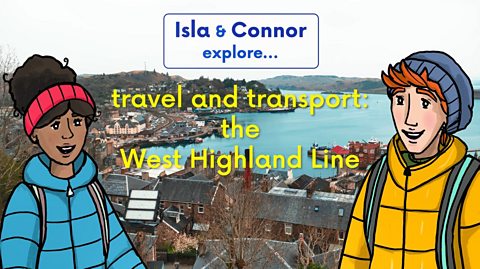Farming and industry
Farming is one of Scotland's most important industries. It provides jobs and brings in money and the food that is produced here is sent all over the world. Farm land takes up almost 80% of Scotland's land area.
In this article you can learn about:
- types of farming in Scotland
- different kinds of industry
- nature reserves and wildlife
This article is suitable for learning about People, Place and Environment topics in primary school.
Video - Farming and industry
Join Isla and Connor as they explore the Badenoch and Speyside Way, and learn more about agriculture and industry.
CONNOR: UmmâŠ
ISLA: Lost, Connor?
CONNOR: I er, I know we're on the Badenoch way, an extension to the Speyside Way, which is a long distance path that stretches over 75 miles from Kingussie, to the mouth of the River Spey, it's just where on the trail we are.
It's all just fields and farms here.
ISLA: That's true.
The land around the River Spey is really good for growing crops.
The river carries silt that makes the soil fertile and helps plants grow, and the flatter land around the river makes using farm machinery easier.
CONNOR: Crops and animals need water too and the river has plenty of that.
We need water for everything.
That's why you often find settlements like towns and villages on rivers.
But you also find farms and other industries.
ISLA: So farming is an industry?
CONNOR: Yes, industry doesn't just mean factories and making things.
Arable farming is a primary industry.
Primary industries provide us with raw materials like crops grown for food, trees cut down for wood, stone dug up for building.
ISLA: So much of what is grown on these farms goes to the food manufacturers and thenâŠ
CONNOR: We eat it!
ISLA: Let's look at the map.
Ruthven Barracks should be just around the bend.
There it is!
The barracks was built here in the 1700s, before that there were medieval castles here.
The site was used for so long because it's in a great position.
It was easy to defend on a hill.
CONNOR: Handy that the river's here for water and fish to eat.
ISLA: The river is narrower and shallower here so that makes it easier to cross, because of that it became a trading point.
People who travelled through could trade their goods for others.
CONNOR: Sometimes the land around the river is too wet for farming or building on, but it's great for wildlife, like wading birds.
Nature reserves like this one, Insh Marshes are protected to look after the environment.
ISLA: Which makes it a great place for visitors like us to come and watch the wildlife.
It's an old mill.
Look, the water would have turned that wheel, which would have powered the mill.
Green energy isn't just a new development.
People have used water and wind power for centuries.
This old mill uses a form of renewable energy.
CONNOR: It says here it's a distillery today.
It uses the water from the river to make whiskey.
Making whiskey is a secondary industry, taking the raw ingredients - in this case, water and the grain called barley - to manufacture another product.
ISLA: Ooh.
This looks like fun.
Water sports on Loch Insh.
Providing attractions for people to visit, activities, like water sports; places to eat; hotels to stay in; they're all examples of tertiary industry.
A tertiary industry provides a service to people.
That can be anything from transport, to hairdressers, to entertainment.
So, primary industry is about growing or gathering raw materials, natural resources like crops.
Secondary industry processes them into other things.
The tertiary industry, or service industry, sells those things to us or offers other kinds of services.
CONNOR: Wow! The River Spey provides so much for all kinds of industries, tourists, wildlife andâŠ
ISLA: Water sports!
Let's go!
What is agriculture?
Agriculture is the practice of farming.
There are many different types of farming in Scotland. What and how people farm can depend on the climate and weather, the type of landscape, and the soil. Here are some examples.
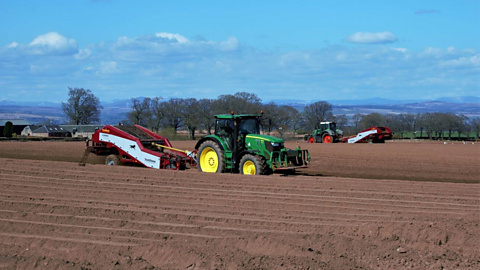
Image caption, Arable land
Arable land is land used to grow crops like grains and vegetables. To grow crops the land needs to be worked - ploughing, planting seeds, harvesting. The type of crop planted will depend on the climate, soil and the time of year, as crops thrive in different conditions. Crops that need tending with large machinery can only be grown on flatter land. (Christina Simpson/Alamy Stock Photo)
Image caption, Pasture
Flat valleys provide space for grazing and pasture. This allows larger flocks of sheep and cattle to graze on grass, on land that might be unsuited to other kinds of farming.(Joe Dunckley/ Alamy Stock Photo)
Image caption, Rough grazing land
This type of land is used for rough grazing livestock, or farm animals such as cattle and sheep. Rough grazing areas are usually uncultivated, which means they haven't been prepared for any planting. These areas can often include moorland and hilly ground, which can be suitable for animals but isnât for farm machinery or crops. (Alan Barnes/ LGBL /Alamy Stock Photo)
Image caption, Crofting
Crofting is unique to Scotland and is an important part of life in the Highlands and Islands. Crofts are small land holdings, which can also include buildings or a house. Crofters work these small areas of land to produce food crops. Common grazing areas are often shared by several crofts for sheep and cows. This type of community activity is part of the culture of crofting, where crofters work together to complete tasks and look after their land. (Gillian Lloyd /Alamy Stock Photo)
1 of 4
Types of farm and produce
Different parts of Scotland are known for different kinds of farming. This is because there is a fairly wide range of types of soil here.
- Cattle and sheep farms can be found throughout Scotland. Sheep farming is the most common type of farm found in the north west, whereas the south west has more cows, raised for beef and dairy farming.
- Cereal farming, for crops such as wheat, oilseed rape, oats and barley, is often found in the east.
- The Scottish climate is relatively mild, which is helpful for growing soft fruits, berries and tomatoes, and introducing greenhouse and polytunnel farming has meant this can happen for more months of the year. These crops are mainly grown in fertile areas such as Angus and Tayside.
Farming and industry
Farming is a hugely important primary industry in Scotland.
Primary industries produce raw materials. Meat, dairy, cereals, vegetables and fruits are either sold directly to customers, or sold to secondary industries.
Secondary industries are manufacturers of different kinds who turn raw materials into new products. For example:
- bakeries use flour to make different kinds of bread
- soft fruit can be used to make fresh jam
- a cheap grain like barley can go through several processes to make an expensive end product like malt whisky.
Tertiary industries are businesses that provide services, like restaurants and shops. Some sell the produce from farms and from food manufacturers to customers. Other tertiary industries include the businesses who transport produce. Much of Scotland's produce, at all levels of industry, is exported, which means it is sent to other countries for sale.
Places to visit on the Badenoch Way and Speyside Way
The Badenoch and Speyside Way walking routes run between Buckie, on the east coast of Scotland, and Newtonmore, in the Cairngorms National Park. There are plenty of interesting places to visit along the way for anyone walking or cycling one of the routes.
Here are a few examples of things you might see.

Image caption, Cairngorms National Park
Much of the Speyside Way runs through the Cairngorms National Park. This is the largest National Park in the UK with some of the most spectacular mountain landscape in Scotland. Visitors come to see the scenery or even climb the mountains.
Image caption, Funicular railway
If you don't want to climb a mountain in the Cairngorms there's another way to enjoy the views! This is the funicular railway, a cable railway which connects points along a railway track laid on a steep slope. This takes people most of the way up Cairn Gorm, which is 1245m high and only a few miles south of the Speyside Way walking route. (John James/Alamy Stock Photo)
Image caption, Aviemore
Aviemore is a popular resort for tourists because it is situated within the Cairngorms National Park. It has lots of amenities like hotels and shops but is still very close to the mountains and wildlife areas. Snow sports such as skiing and other outdoor activities such as hiking and rafting bring tourists here at different times of the year. (Travel Scotland - Paul White / Alamy Stock Photo)
Image caption, Ruthven Barracks
Ruthven Barracks was built in 1719 on the site of an old castle. It was chosen as a base for King George IIâs soldiers so they could maintain order after the failed Jacobite rebellion of 1715. It is clear why the site was chosen for a barracks (and before that for a castle). It is in an excellent defensive position on a hill, with a clear view of any approaching armies, and the river and forest nearby would provide food and water. (Green Planet Photography / Alamy Stock Photo)
Image caption, Speyside Cooperage
Speyside Cooperage in Craigellachie is the only working cooperage in the UK where visitors can see barrels being made in the traditional way. The barrels, or casks, are made from oak wood and hold whisky while it matures. As whisky is also a local industry on Speyside this is a good example of different industries working together to provide different products and experiences that visitors will want to buy. (Image Professionals GmbH/Alamy Stock Photo)
Image caption, Balvenie Castle
Slightly off the Speyside Way, south of the Cooperage near Dufftown is Balvenie Castle. It is one of the oldest stone built castles in the UK, dating back to the late 13th century. It was used by the King's forces as a place to camp during the second Jacobite Rebellion in 1745. (robertharding/Alamy Stock Photo)
Image caption, Spey Bay
Spey Bay is where the Speyside Way meets the sea. It is a coastal reserve and the largest shingle beach in Scotland. It is the perfect habitat for breeding terns in summer, and if you're lucky you might see the bottlenose dolphins at the river mouth! (Sally Anderson/Alamy Stock Photo)
1 of 7
Learn more about Ruthven Barracks, which can be found along the Badenoch Way: Our Landscapes Then and Now: Ruthven Barracks
Insh Marsh National Nature Reserve
Nature reserves are areas of land or water, containing species or habitats of national importance.
The Insh Marshes are an area of floodplainThe flat area that stretches from a river to the sides of a valley. The floodplain will often become covered in water in times of flood. near Kingussie. It is one of the most important wetlands in Europe. The River Spey bursts its banks and floods the land here several times a year, which makes it a perfect habitatThe natural home of a plant or an animal. for hundreds of plant species and several rare birds. Here are a few things you might find in the reserve.
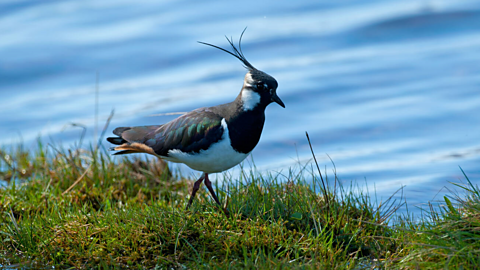
Image caption, Lapwings
Breeding waders such as lapwings, curlews and redshanks love the floodplain in spring and summer. The marsh is one of the most important wetland areas in Europe for these types of birds. (David Gowans / Alamy Stock Photo)
Image caption, Ospreys
Ospreys fish in Loch Inch and the River Spey in the spring and summer. In the colder months, they migrate to North Africa, before returning to Insh Marshes every year. (Nature Picture Library / Alamy Stock Photo)
Image caption, Greylag geese
In the autumn, greylag geese arrive at Insh Marsh from Iceland. They stay throughout the autumn and winter with other migrating birds, such as whooper swans (Doug McCutcheon / Alamy Stock Photo)
Image caption, Hen harriers
Hen harriers are birds of prey, which means they feed on other animals. They come to Insh Marsh to roost in the autumn and winter. (Nature Picture Library/Alamy Stock Photo)
1 of 4

Key words about farming and industry
Sorry, something went wrongCheck your connection, refresh the page and try again. - farming and cultivating land for rearing animals and growing crops.
Sorry, something went wrongCheck your connection, refresh the page and try again. - an industry like forestry, mining or agriculture that provides raw materials, either straight to the customer or for making other products.
Sorry, something went wrongCheck your connection, refresh the page and try again. - an industry that makes something from raw materials to create a new product.
Sorry, something went wrongCheck your connection, refresh the page and try again. - an industry that provides services.
Sorry, something went wrongCheck your connection, refresh the page and try again. - an area of land or water, containing species or habitats of national importance.
Sorry, something went wrongCheck your connection, refresh the page and try again. - land that is used for farming.
Sorry, something went wrongCheck your connection, refresh the page and try again. - land that hasn't been worked for planting, for rearing animals.
Sorry, something went wrongCheck your connection, refresh the page and try again. - farm animals raised for produce.
Test your knowledge
Quiz
Challenge

Design a poster showing how the produce grown locally to you might make it from the farm to your plate.
Research what kinds of crops and animals are farmed nearby and why that might be - what is the landscape like? (If you live in a city, think about neighbouring areas and the farms closest to you). Think about the steps each product makes on the way from the field to you.
Here is a guide on how to make a poster to help you get started!
Our landscape
Pupils from Kingussie Primary School share their facts and personal reflections about Ruthven Barracks, their local landmark.
Hi. We are P6/7 from Kingussie Primary School. And this is our film all about Ruthven Barracks.
It was originally pronounced âRivvenâ but lots of people now say âRuthvenâ.
Ruthven Barracks is the remains of an 18th century military building near Kingussie.
It was built between 1719 and 1721.
It was constructed on the site of a medieval castle.
The well is the only part of the castle thatâs still visible.
It was built by George II to police the area after the Jacobite Uprising of 1715.
The Jacobites were supporters of King James VII of Scotland and II of England
The word Jacobite comes from Latin for James, which is Jacobus.
Itâs a good example of the kind of buildings made at the time by the military in the Highlands.
The fort has two barrack buildings and could hold two companies of soldiers and their officers when filled.
It also had a guardhouse, a bake house, a brew house and a prison.
There were also stables that could hold up to 28 horses.
The horses were used to protect the troops on the military road.
The building was attacked by the Jacobites several times over the period it was being used.
Here are some of our own stories about the barracks.
I like to go to Ruthven Barracks to have fun and to take selfies.
I like going in the prison and pretending Iâm a prisoner.
I like when you drive past at night and itâs all lit up. It looks incredible.
I like going with my family because the views are fantastic.
I like looking at Ruthven Barracks and knowing there were lots of brave soldiers there.
My mum and dad had their wedding photos taken there.
I like seeing the Highland cows and the other animals in the fields around the barracks.
Hopefully one day you can come and visit Ruthven Barracks. Weâve been Kingussie Primary, thanks for watching.
Farm to plate
Learn more about food journeys with this helpful guide
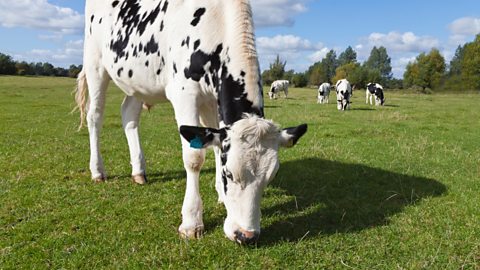
Food and sustainability. revision-guideFood and sustainability
Learn about the impact of food choices on the environment.
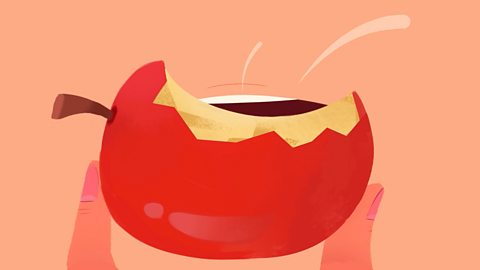
More on Landscapes
Find out more by working through a topic
- count6 of 25
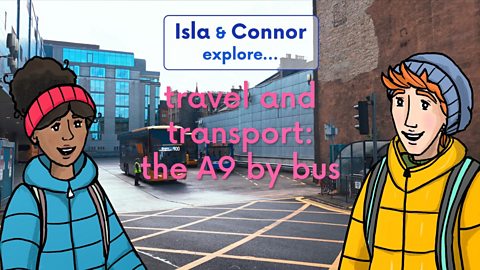
- count7 of 25
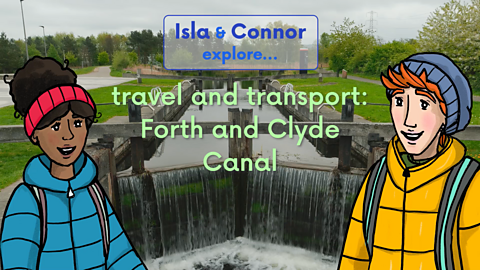
- count9 of 25
